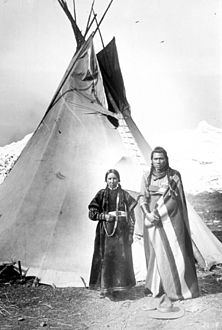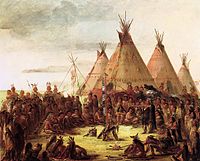Tipi

A tipi (also teepee, tepee) is a conical tent originally made of animal skins or birch bark and popularized by the Native Americans of the Great Plains. The dwelling was remarkably durable, and gave warmth and comfort to its inhabitants during harsh winters, was dry during heavy rains, and cool during the heat of summers. It was portable, which was an important factor since most Plains Indians were highly mobile, and could be broken down and packed away quickly when a tribe decided to move, and could be constructed just as quickly when a tribe settled an area. Native Americans are stereotypically associated with tipis, even though Native Americans from places other than the Great Plains built different types of dwellings.
Today, they are usually covered in canvas and lived in by American Indian families attending Powwows or Encampments, teaching further generations of traditions. Tipis are also used by historical reenactors and "back to the land" people, and in some places they are used for tourist lodgings.
The word "tipi" comes into English from the Lakota language; the word thípi consists of two elements: the verb thí, meaning "to dwell," and a pluralizing enclitic (a suffix-like ending that marks the subject of the verb as plural), pi, and means "they dwell." In Lakota, formal verbs can be used as nouns, and this is the case with thípi, which in practice just means "house."
The term "wigwam" is sometimes incorrectly used to refer to a dwelling of this type.
Elements

Tipis consist of four elements: a set of ten to twenty sapling poles (depending on the size of the tipi), a canvas or skin cover (the outer shape familiar from photographs), an optional inner canvas or skin lining/ozan, and a canvas or skin door. Ropes and pegs are required to bind the poles, close the cover, attach the lining and door, and anchor the resulting structure to the ground. Tipis are distinguished from other tents by two crucial innovations: the opening at the top and the smoke flaps, which allow the dweller to cook and heat themselves with an open fire, and the lining, which insulates while providing a source of fresh air to fire and dwellers. Tipis are designed to be easily set up to allow camps to be moved to follow game migrations, especially the bison. The long poles could be used to construct a dog- or later horse-pulled travois.
Tipi covers are made by sewing together strips of canvas or hide and cutting out a semicircular shape from the resulting surface. Trimming this shape yields a door and the smoke flaps that allow the dwellers to control the chimney effect to expel smoke from their fires. Old style traditional linings/ozans were hides, blankets, and retangular pieces of cloth hanging about four to five feet above the ground tied to the poles or a rope. Todays modern lining is the most difficult element to measure, since it consists of lozenge-shaped strips of canvas assembled to form the shape of a truncated cone. The poles, made of peeled, polished and dried tapering saplings, are cut to measure about six feet more than the radius of the cover.
Construction

The first step in setting up a tipi is to tie together three of the poles at the skin's radius from their bases. One end of this lashing rope is left dangling from the tie-point, long enough to reach the base of the poles. These tripod poles are stood upright, with their unfastened ends spaced apart on the ground to form a triangle, each pole's base the skin's radius from its neighbors. A dozen more long poles are laid onto the three primary poles. Their upper ends rest on the lashing of the first three, and the lower ends are evenly spaced to form a circle on the ground which includes the original three poles. The lashing rope is then walked around the whole structure three times and pulled tight. This ties the placed poles to the tripod at the crown of the tipi. The canvas skin is tied to another pole, lifted up and the top of the pole is rested where all the poles meet. The skin is pulled around the pole framework. The overlap seam is closed with wooden lacing pins which are thin sticks about 10 inches long with one or both ends tapered. Sometimes a door is attached to one of the bottom lacing pins. In old tipis of hide or early cloth, the door was where the two sides came together in the front. A blanket, hide or cloth door was put over the opening to secure the entrance.
The base of the skin is pegged to the ground. Traditionally pegs were placed in slits at the bottom of the cover. As canvas or cloth came into use, smooth pebbles were pushed into the cloth and a cord tied between the bulge of cloth and a wooden peg in the ground. A gap can be allowed at ground level for airflow in warm seasons and the base is completely closed to the ground in cooler times. The bases of the non-tripod poles are moved in or out to tension the skin. Inside the tipi, a cord is wrapped from pole to pole above head height. An inner lining/ozan can be suspended from this cord and pushed back on the ground near the inside base of the poles. An interior awning helps prevents rain drips hitting bedding, can be suspended at the top of the lining. Bedding and personal items are pushed against the liner to keep it in place. The inner lining acts as a heat insulator and draft and pest excluder. A liner is not necessary in warm weather.
Use

The tipi was designed to enable an indoor fire for heating and sometimes cooking. The fire is set in the center of the bare floor. There are two smoke flaps at the top of the tipi which can be adjusted with long poles. These smoke flaps are set at right angles to the wind, preventing the wind blowing down the chimney. In historic tipis a liner or ozan was used in winter and to help prevent drafts. A liner aids in keeping inhabitants warm in winter. To enable a fire in inclement weather, when the liner is closed completely, a buried pipe can be installed which brings air directly to the base of the fire.
In strong winds the lashing rope is pegged to the ground behind the fire. This helps to keep the tipi poles from “walking”, lifting up under the force of the wind on the skin and coming down in a new position. A tipi which is pegged around the base and has had its lashing rope tied down is a remarkably wind-resistant cone.
In hot weather the lining is not used, the out side skin is unpegged and is rolled up a few feet on two sides. Any small breeze creates ventilation.
A tipi is not the best shelter during times of intense rain. Contemporary tipi-dwellers tie a bucket beneath the crown, or install rubber barriers on the poles and a canvas rain-catcher which drains from the crown to the outside, to collect rain dripping off the crown of the poles.
See also

Further reading
- Laubin, Reginald, Gladys Laubin, (Tatanka Wanjila na Wiyaka Wastewin) and Stanley Vestal, "The Indian tipi : its history, construction, and use". 2nd ed., Norman, University of Oklahoma Press, 1957. LCCN 57005958 ISBN 0-8061-2236-6
- Holley, Linda A., Tipis | Tepees | Teepees: History, design, and evolution of the cloth tipi. Gibbs Smith, 2007 ISBN 978-1-58685-511-6
External links and references
- Housing, Dwellings & Shelters: Tipi, tipi building resource, how-to manuals and online calculator for canvas lanes
- Tipi Instructions, a PDF document detailing the construction of a tipi.
- History, construction, and evolution of tipis
- Photos and drawings
